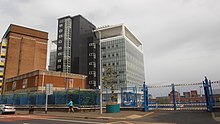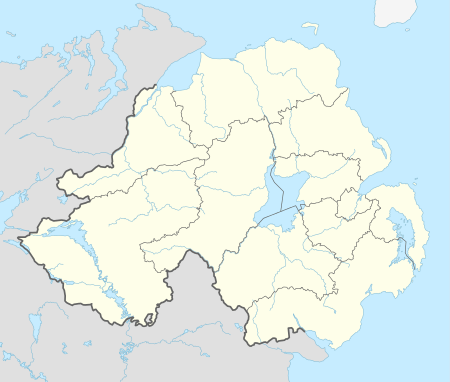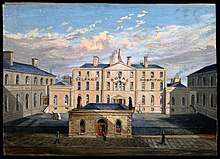Royal Victoria Hospital, Belfast
The Royal Victoria Hospital commonly known as "the Royal", the "RVH" or "the Royal Belfast", is a hospital in Belfast, Northern Ireland. It is managed by the Belfast Health and Social Care Trust. The hospital has a Regional Virus Centre, which is one of the four laboratories in the United Kingdom on the WHO list of laboratories able to perform PCR for rapid diagnosis of influenza A (H1N1) virus infection in humans.[1]
| Royal Victoria Hospital | |
|---|---|
| Belfast Health and Social Care Trust | |
 Royal Victoria Hospital | |

| |
 Location in Northern Ireland | |
| Geography | |
| Location | 274 Grosvenor Road, Belfast, Northern Ireland |
| Coordinates | 54.5947°N 5.9538°W |
| Organisation | |
| Care system | Health and Social Care |
| Type | District General |
| Affiliated university | |
| Services | |
| Emergency department | Yes |
| History | |
| Opened | 1797 |
| Links | |
| Website | belfasttrust |
History
Early history


The Royal Victoria Hospital has its origins in a number of successive institutions, beginning in 1797 with The Belfast Fever Hospital and General Dispensary, located in Factory Row (although the dispensary originally opened in 1792). This moved to West Street in 1799, and then to Frederick Street in 1817.[2] In 1847 the hospital separated from the General Dispensary and became the Belfast General Hospital. In 1875 it gained the royal charter,[3] becoming the Belfast Royal Hospital, and in 1899 it was renamed the Royal Victoria Hospital. In 1903 it moved from Frederick Street to its present (Grosvenor Road) site.[4]
Grosvenor Road
The first hospital building on the Grosvenor Road site was designed in 1899 by architects Henman and Cooper of Birmingham[5] in a partial adoption of the English Revival style.[6] The design incorporates a turreted verandah-balcony extending along a series of ward pavilions.[7] The hospital became the first air-conditioned public building in the world when Belfast's Sirocco Works installed the system.[8] It was officially opened by King Edward VII and Queen Alexandra on 27 July 1903.[9] The King Edward Building, built to commemorate the life of the late king, was completed in 1915.[9] The Royal Maternity Hospital was officially opened on the site previously occupied by the Belfast Asylum, to the immediate south of the main hospital, in 1933.[10] Later additions included a free-standing radiology department and theatre block in 1964.[9]

A slight addition to the main front of the West Belfast site was new railings (on Falls Road, going west from the junction of Grosvenor and Springfield Roads) completed in 2000. The wavy pattern of the railings erected was reminiscent of the structure of DNA. There were little yellow Xs and Ys detailed for X- and Y-chromosomes, and portraits (laser-cut in sheet steel) chart the progress of a human life from birth to the age of 100.[11][12]
In February 2003 the hospital was designated as one of the nine acute hospitals in the acute hospital network of Northern Ireland on which healthcare would be focused under the government health policy 'Developing Better Services'.[13]
The Prince of Wales opened a new 400 bed, seven storey building, which incorporated new intensive care and fracture units built at a cost of £42 million,[14] in September 2003.[15] New imaging and central decontamination centres were added in 2007.[16]
Construction started on a new critical care facility, being built at a cost of £150 million, in 2008.[17] However, due to construction difficulties, the project is understood to be running at least five years late[17] and will not be fully open until 2021.[18]
Staff and patients
Frank Pantridge, the "father of emergency medicine", was a cardiac consultant at the hospital for over 30 years. During his time at the Royal, Pantridge developed the portable defibrillator, which revolutionised emergency medicine by allowing patients to be treated early by paramedics.[19]
Social Democratic and Labour Party (SDLP) politician Carmel Hanna worked as a nurse in the hospital. Progressive Unionist Party (PUP) politician David Ervine was admitted on 7 January 2007 and died there the following day. During the Northern Ireland Troubles, the hospital was regarded as one of the best hospitals in the world for the treatment of gunshot wounds. Gunshots to the knee (associated with paramilitary punishment attacks in Northern Ireland) enabled surgeons at the hospital to gain renown with their treatment of such injuries.[20][21]
Performance
In November 2013 it was reported that the Royal College of Emergency Medicine considered that issues faced by clinicians in the casualty department are probably worse than anywhere else in the UK.[22]
The Royal Victoria Hospital has, in recent years, been criticised by health professionals due to its long waiting time at Accident and Emergency; this has resulted in patients and emergency ambulances being delayed and having to queue outside the hospital for hours at a time.[23]
References
- "List of countries able to perform PCR to diagnose influenza A (H1N1) virus infection in humans" (PDF). World Health Organisation. 8 May 2009. Retrieved 1 April 2019.
- Bridges, Barry. "Belfast Medical Students" (PDF). Queen's University of Belfast. p. 14. Retrieved 3 April 2019.
- Froggatt, Richard. "Sir William Whitla (1851–1933)". The Dictionary of Ulster Biography. Retrieved 25 December 2014.
- Froggatt, Sir Peter; Bridges, Prof. Barry (1985). The Belfast Medical School 1835–1985 (PDF). Ulster Medical Society. p. 7. Retrieved 25 December 2014.
- Banham, Reyner (1969). Architecture of the Well-tempered Environment. Architectural Press. pp. 75–84. ISBN 978-0-85139-073-4. Retrieved 25 December 2014.
- Becker, Annette; Olley, John; Wang, Wilfried, eds. (1997). 20th-century Architecture: Ireland. Munich, New York and Frankfurt: Prestel. ISBN 9783791317199.
- "Royal Victoria Hospital". Historic Hospitals. Retrieved 1 April 2019.
- "Raise a glass to a hole new look at Belfast's forgotten past". Belfast Telegraph. 28 April 2011. Retrieved 1 April 2019.
- Clarke, Richard (1997). "History of the Royal Victoria Hospital" (PDF). Ulster Medical Society. Retrieved 1 April 2019.
- Houston, J K; O'sullivan, J F (1986). Midwifery in the Belfast City Hospital, Northern Ireland, 1842–1985. Belfast.
- Lonely Planet Website www.lonelyplanet.com : Worldguide to Northern Ireland / Belfast / Sights By Lonely Planet Guides.
- "Royal Victoria Hospital, Belfast". Hansard. 6 April 2000. Retrieved 1 April 2019.
- Department of Health NI. "Developing Better Health Services (Topic: Health policy)". Department of Health NI. Retrieved 27 March 2019.
- "Aecom". Find an Architect. Retrieved 1 April 2019.
- "Prince opens memorial garden". BBC. 2 September 2003. Retrieved 1 April 2019.
- "Royal Victoria Hospital, Belfast". Historic Hospitals. Retrieved 1 April 2019.
- "Royal Victoria Hospital, Belfast: Opening of £150m critical care building delayed again". BBC. 24 March 2015. Retrieved 1 April 2019.
- "Delay to full opening of Royal Victoria Hospital critical care building branded a 'disgrace'". Belfast Telegraph. 20 March 2018. Retrieved 1 April 2019.
- Bill Duff, "Frank Pantridge (obituary)". The Guardian, 5 January 2005. Retrieved 13 January 2012.
- Barr, R J; Mollan, R A B (1 November 1989). "The Orthopaedic Consequences of Civil Disturbance in Northern Ireland" (PDF). The Journal of Bone and Joint Surgery: 739–744. Cite journal requires
|journal=(help) - "Twenty five years of vascular trauma in Northern Ireland". British Medical Journal. 7 January 1995. Retrieved 1 April 2019.
- "Belfast A&E staff pressures 'unsustainable' says report". BBC News. 9 November 2013. Retrieved 9 November 2013.
- Connolly, Marie-Louise (23 October 2013). "Royal A&E waiting times 'excessive'". BBC News. Retrieved 17 April 2018.
External links
| Wikimedia Commons has media related to Royal Victoria Hospital, Belfast. |
- Official website

- Inspection reports from the Regulation and Quality Improvement Authority